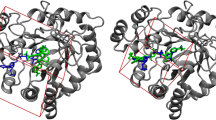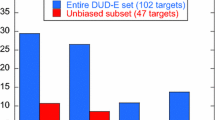Abstract
In the current study an innovative method of structural filtration of docked ligand poses is introduced and applied to improve the virtual screening results. The structural filter is defined by a protein-specific set of interactions that are a) structurally conserved in available structures of a particular protein with its bound ligands, and b) that can be viewed as playing the crucial role in protein-ligand binding. The concept was evaluated on a set of 10 diverse proteins, for which the corresponding structural filters were developed and applied to the results of virtual screening obtained with the Lead Finder software. The application of structural filtration resulted in a considerable improvement of the enrichment factor ranging from several folds to hundreds folds depending on the protein target. It appeared that the structural filtration had effectively repaired the deficiencies of the scoring functions that used to overestimate decoy binding, resulting into a considerably lower false positive rate. In addition, the structural filters were also effective in dealing with some deficiencies of the protein structure models that would lead to false negative predictions otherwise. The ability of structural filtration to recover relatively small but specifically bound molecules creates promises for the application of this technology in the fragment-based drug discovery.

Improvement of virtual screening performance by structural filtration for ADRB2 as a target. Positions of the native ligands obtained during virtual screening are depicted by vertical bars. Upper part of the plot corresponds to the performance of docking-based screening; lower part - docking-based screening followed by structural filtration. Lower part of the plot contains all (48) native ligands of ADRB2, which fall into the top 0.6% of the screened library.



Similar content being viewed by others
References
Richon AB (2008) Current status and future direction of the molecular modeling industry. Drug Discov Today. doi:10.1016/j.drudis.2008.04.008
Cheeseright TJ, Mackey MD, Melville JL, Vinter JG (2008) FieldScreen: virtual screening using molecular fields. Application to the DUD data set. J Chem Inf Model. doi:10.1021/ci800110p
Warren GL, Andrews CW et al (2006) A critical assessment of docking programs and scoring functions. J Med Chem. doi:10.1021/jm050362n
Tan L, Geppert H, Sisay MT, Gütschow M, Bajorath J (2008) Integrating structure- and ligand-based virtual screening: comparison of individual, parallel, and fused molecular docking and similarity search calculations on multiple targets. ChemMedChem. doi:10.1002/cmdc.200800129
Muthasa D, Sabnisa YA, Lundborga M, Karlén A (2008) Is it possible to increase hit rates in structure-based virtual screening by pharmacophore filtering? An investigation of the advantages and pitfalls of post-filtering. J Mol Graph Model. doi:10.1016/j.jmgm.2007.11.005
Deng Z, Chuaqui C, Singh J (2004) Structural Interaction Fingerprint (SIFt): a novel method for analyzing three-dimensional protein-ligand binding interactions. J Med Chem. doi:10.1021/jm030331x
Marcou G, Rognan D (2007) Optimizing fragment and scaffold docking by use of molecular interaction fingerprints. J Chem Inf Model. doi:10.1021/ci600342e
Hindle SA, Rarey M, Buning C, Lengauer T (2002) Flexible docking under pharmacophore type constraints. J Comput-Aided Mol Des. doi:10.1023/A:1016399411208
Baroni M, Cruciani G, Sciabola S, Perruccio F, Mason JS (2007) A common reference framework for analyzing/comparing proteins and ligands. Fingerprints for Ligands and Proteins (FLAP): theory and application. J Chem Inf Model. doi:10.1021/ci600253e
Nandigam RK, Kim S, Singh J, Chuaqui C (2009) Position specific interaction dependent scoring technique for virtual screening based on weighted protein-ligand interaction fingerprint profiles. J Chem Inf Model. doi:10.1021/ci800466n
Stroganov OV, Novikov FN, Stroylov VS, Kulkov V, Chilov GG (2008) Lead finder: an approach to improve accuracy of protein–ligand docking, binding energy estimation, and virtual screening. J Chem Inf Model. doi:10.1021/ci800166p
Berman HM, Westbrook J, Feng Z, Gilliland G, Bhat TN, Weissig H, Shindyalov IN, Bourne PE (2000) The protein data bank. Nucleic Acids Res 28:235–242
Zhanga J, Aizawaa M, Amaria S, Iwasawab Y, Nakanoc T, Nakatac K (2004) Development of KiBank, a database supporting structure-based drug design. Comput Biol Chem. doi:10.1016/j.compbiolchem.2004.09.003
STK library (2007) Vitas-M Laboratory, Moscow. http://www.vitasmlab.com/compound-libraries-2.htm. Accessed 15 Jul 2009
Cherezov V, Rosenbaum DM, Hanson MA et al (2007) High-resolution crystal structure of an engineered human β2-Adrenergic G protein-coupled receptor. Science. doi:10.1126/science.1150577
Acknowledgments
We thank Val Kulkov (BioMolTech Corp) for revising the manuscript. Our special thanks to Prof. Viktor Gergel and Alexander Grishagin, the Center of Supercomputer Technologies of the N.I. Lobacevsky State University of Nizhni Novgorod, for our access to the high-performance computing cluster (Nizhni Novgorod segment of the SKIF-grid program). The work was supported by the Foundation of Assistance to Small Innovative Enterprises (Contract №7168/4935r)
Author information
Authors and Affiliations
Corresponding author
Electronic supplementary material
Below is the link to the electronic supplementary material.
ESM 1
(DOC 80 kb)
Table S1
Average physicochemical properties of native ligands of the studied target proteins. (XLS 22 kb)
Table S2
Docking of native ligands to their targets. (DOC 234 kb)
Figure S1
Enrichment plots corresponding to the docking-based virtual screening. True positive ligand rate (TP%) is plotted against the true negative rate (TN%). (DOC 88 kb)
Figure S2
Enrichment plots corresponding to the docking-based virtual screening followed by structural filtration of docked ligand poses. True positive ligand rate (TP%) is plotted against the true negative rate (TN%). (DOC 81 kb)
Rights and permissions
About this article
Cite this article
Novikov, F.N., Stroylov, V.S., Stroganov, O.V. et al. Improving performance of docking-based virtual screening by structural filtration. J Mol Model 16, 1223–1230 (2010). https://doi.org/10.1007/s00894-009-0633-8
Received:
Accepted:
Published:
Issue Date:
DOI: https://doi.org/10.1007/s00894-009-0633-8




